Effects of Wind, Waves, and Currents on Icebergs and Surface Floats in the Labrador Sea: A Modeling Study
Abstract
:1. Introduction
2. Theory
2.1. Iceberg Drift
2.2. Ocean Currents in the Surface Layer
3. Data and Methods
4. Results
4.1. Surface Floats
4.2. Icebergs
5. Conclusions
Author Contributions
Funding
Data Availability Statement
Acknowledgments
Conflicts of Interest
References
- Hooke, R.L. Principles of Glacier Mechanics; Cambridge University Press: Cambridge, MA, USA, 2005. [Google Scholar]
- Martin, T.; Adcroft, A. Parameterizing the fresh-water flux from land ice to ocean with interactive icebergs in a coupled climate model. Ocean Model. 2010, 34, 111–124. [Google Scholar] [CrossRef]
- Bigg, G.R.; Wadley, M.R.; Stevens, D.P.; Johnson, J.A. Prediction of iceberg trajectories for the North Atlantic and Arctic oceans. Geophys. Res. Lett. 1996, 23, 3587–3590. [Google Scholar] [CrossRef] [Green Version]
- Schild, K.M.; Sutherland, D.A.; Elosegui, P.; Duncan, D. Measurements of Iceberg Melt Rates Using High-Resolution GPS and Iceberg Surface Scans. Geophys. Res. Lett. 2021, 48, e2020GL089765. [Google Scholar] [CrossRef]
- Bigg, G.R.; Wadley, M.R.; Stevens, D.P.; Johnson, J.A. Modelling the dynamics and thermodynamics of icebergs. Cold Reg. Sci. Technol. 1997, 26, 113–135. [Google Scholar] [CrossRef] [Green Version]
- Wagner, T.J.; Dell, R.W.; Eisenman, I. An analytical model of iceberg drift. J. Phys. Oceanogr. 2017, 47, 1605–1616. [Google Scholar] [CrossRef]
- Smith, S.D. Hindcasting iceberg drift using current profiles and winds. Cold Reg. Sci. Technol. 1993, 22, 33–45. [Google Scholar] [CrossRef]
- Kubat, I.; Sayed, M.; Savage, S.B.; Carrieres, T. An operational model of iceberg drift. Int. J. Offshore Polar Eng. 2005, 15, ISOPE-05-15-2-125. [Google Scholar]
- Turnbull, I.D.; Fournier, N.; Stolwijk, M.; Fosnaes, T.; McGonigal, D. Operational iceberg drift forecasting in Northwest Greenland. Cold Reg. Sci. Technol. 2015, 110, 1–18. [Google Scholar] [CrossRef]
- Marko, J.; Birch, J.; Wilson, M. A study of long-term satellite-tracked iceberg drifts in Baffin Bay and Davis Strait. Arctic 1982, 35, 234–240. [Google Scholar] [CrossRef] [Green Version]
- Gladstone, R.M.; Bigg, G.R.; Nicholls, K.W. Iceberg trajectory modeling and meltwater injection in the Southern Ocean. J. Geophys. Res. Oceans 2001, 106, 19903–19915. [Google Scholar] [CrossRef] [Green Version]
- Hunke, E.C.; Comeau, D. Sea ice and iceberg dynamic interaction. J. Geophys. Res. Oceans 2011, 116. [Google Scholar] [CrossRef] [Green Version]
- Losch, M.; Menemenlis, D.; Campin, J.M.; Heimbach, P.; Hill, C. On the formulation of sea-ice models. Part 1: Effects of different solver implementations and parameterizations. Ocean Model. 2010, 33, 129–144. [Google Scholar] [CrossRef] [Green Version]
- Hill, J.C.; Condron, A. Subtropical iceberg scours and melt water routing in the deglacial western North Atlantic. Nat. Geosci. 2014, 7, 806–810. [Google Scholar] [CrossRef]
- Jongma, J.I.; Driesschaert, E.; Fichefet, T.; Goosse, H.; Renssen, H. The effect of dynamic-thermodynamic icebergs on the Southern Ocean climate in a three-dimensional model. Ocean Model. 2009, 26, 104–113. [Google Scholar] [CrossRef]
- Bügelmayer, M.; Roche, D.M.; Renssen, H. How do icebergs affect the Greenland ice sheet under pre-industrial conditions?—A model study with a fully coupled ice-sheet–climate model. Cryosphere 2015, 9, 821–835. [Google Scholar] [CrossRef] [Green Version]
- Fitzmaurice, A. Parameterizing the Melting of Icebergs in Global Climate Models. Ph.D. Thesis, Princeton University, Princeton, NJ, USA, 2018. [Google Scholar]
- Maximenko, N.; Hafner, J.; Kamachi, M.; MacFadyen, A. Numerical simulations of debris drift from the Great Japan Tsunami of 2011 and their verification with observational reports. Mar. Pollut. Bull. 2018, 132, 5–25. [Google Scholar] [CrossRef]
- Roemmich, D.; Johnson, G.; Riser, S.; Davis, R.; Gilson, J.; Owens, W.; Garzoli, S.; Schmid, C.; Ignaszewski, M. The Argo Program: Observing the global ocean with profiling floats. Oceanography 2009, 22, 34–43. [Google Scholar] [CrossRef] [Green Version]
- Cushman-Roisin, B.; Chassignet, E.P.; Tang, B. Westward motion of mesoscale eddies. J. Phys. Oceanogr. 1990, 20, 758–768. [Google Scholar] [CrossRef]
- Afanasyev, Y.D. Altimetry in a GFD laboratory and flows on the polar β-plane. In Modelling Atmospheric and Oceanic Flows: Insights from Laboratory Experiments and Numerical Simulations; von Larcher, T., Williams, P., Eds.; AGU Wiley: Hoboken, NJ, USA, 2015; Chapter 5; pp. 101–117. [Google Scholar]
- Afanasyev, Y.D.; O’Leary, S.; Rhines, P.B.; Lindahl, E.G. On the origin of jets in the ocean. Geoph. Astroph. Fluid Dyn. 2012, 106, 113–137. [Google Scholar] [CrossRef]
- Afanasyev, Y.D.; Rhines, P.B.; Lindahl, E.G. Velocity and potential vorticity fields measured by altimetric imaging velocimetry in the rotating fluid. Exp. Fluids 2009, 47, 913–926. [Google Scholar] [CrossRef]
- Zhang, Y.; Afanasyev, Y. Beta-plane turbulence: Experiments with altimetry. Phys. Fluids 2014, 26, 026602. [Google Scholar] [CrossRef] [Green Version]
- Matulka, A.M.; Zhang, Y.; Afanasyev, Y.D. Complex environmental β-plane turbulence: Laboratory experiments with altimetric imaging velocimetry. Nonlinear Process. Geophys. 2016, 23, 21–29. [Google Scholar] [CrossRef] [Green Version]
- Zhang, Y.; Afanasyev, Y. Baroclinic turbulence on the polar beta-plane in the rotating tank: Down to submesoscale. Ocean Model. 2016, 107, 151–160. [Google Scholar] [CrossRef]
- Afanasyev, Y.D. Turbulence, Rossby waves and zonal jets on the polar β-plane: Experiments with laboratory altimetry. In Zonal Jets: Phenomenology, Genesis, and Physics; Galperin, B., Read, P.L., Eds.; Cambridge University Press: New York, NY, USA, 2019; Chapter 8; pp. 152–166. [Google Scholar]
- Wu, K.; Liu, B. Stokes drift–induced and direct wind energy inputs into the Ekman layer within the Antarctic Circumpolar Current. J. Geophys. Res. Oceans 2008, 113. [Google Scholar] [CrossRef] [Green Version]
- Hui, Z.; Xu, Y. The impact of wave-induced Coriolis-Stokes forcing on satellite-derived ocean surface currents. J. Geophys. Res. Oceans 2016, 121, 410–426. [Google Scholar] [CrossRef] [Green Version]
- Ekman, V.W. On the Influence of the Earth’s Rotation on Ocean-Currents; Arch. Math. Astron. Phys. 1905, 2, 1–52. [Google Scholar]
- Santiago-Mandujano, F.; Firing, E. Mixed-layer shear generated by wind stress in the central equatorial Pacific. J. Phys. Oceanogr. 1990, 20, 1576–1582. [Google Scholar] [CrossRef] [Green Version]
- Liu, B.; Wu, K.; Guan, C. Global estimates of wind energy input to subinertial motions in the Ekman-Stokes layer. J. Oceanogr. 2007, 63, 457–466. [Google Scholar] [CrossRef]
- Polton, J.A.; Lewis, D.M.; Belcher, S.E. The role of wave-induced Coriolis–Stokes forcing on the wind-driven mixed layer. J. Phys. Oceanogr. 2005, 35, 444–457. [Google Scholar] [CrossRef]
- Philipps, O.M. The Dynamics of the Upper Ocean; Cambrige University Press: Cambrige, MA, USA, 1977. [Google Scholar]
- Hersbach, H.; Bell, B.; Berrisford, P.; Biavati, G.; Horányi, A.; Muñoz Sabater, J.; Nicolas, J.; Peubey, C.; Radu, R.; Rozum, I.; et al. ERA5 Hourly Data on Single Levels from 1959 to Present. Copernicus Climate Change Service. Climate Data Store (CDS). 2018. Available online: https://cds.climate.copernicus.eu/#!/home (accessed on 6 May 2022).
- Hersbach, H.; Berrisford, B.B.; Hirahara, S.; Horányi, A.; Muñoz-Sabater, J.; Peubey, J.N.; Radu, R.; Schepers, D.; Simmons, A.; Soci, C.; et al. The ERA5 global reanalysis. Q. J. R. Meteorol. Soc. 2020, 146, 1999–2049. [Google Scholar] [CrossRef]
- Li, F.; Lozier, M.S.; Bacon, S.; Bower, A.S.; Cunningham, S.A.; de Jong, M.F.; deYoung, B.; Fraser, N.; Fried, N.; Han, G.; et al. Subpolar North Atlantic western boundary density anomalies and the Meridional Overturning Circulation. Nat. Commun. 2021, 12, 3002. [Google Scholar] [CrossRef] [PubMed]
- New, A.L.; Smeed, D.A.; Czaja, A.; Blaker, A.T.; Mecking, J.V.; Mathews, J.P.; Sanchez-Franks, A. Labrador Slope Water connects the subarctic with the Gulf Stream. Environ. Res. Lett. 2021, 16, 084019. [Google Scholar] [CrossRef]
- Pennelly, C.; Myers, P.G. Impact of different atmospheric forcing sets on modeling Labrador Sea Water production. J. Geophys. Res. Oceans 2021, 126, e2020JC016452. [Google Scholar] [CrossRef]
- Holland, D.M.; Thomas, R.H.; De Young, B.; Ribergaard, M.H.; Lyberth, B. Acceleration of Jakobshavn Isbræ triggered by warm subsurface ocean waters. Nat. Geosci. 2008, 1, 659–664. [Google Scholar] [CrossRef]
- Garrett, C.; Middleton, J.; Hazen, M.; Majaess, F. Tidal Currents and Eddy Statistics from Iceberg Trajectories off Labrador. Science 1985, 227, 1333–1335. [Google Scholar] [CrossRef]
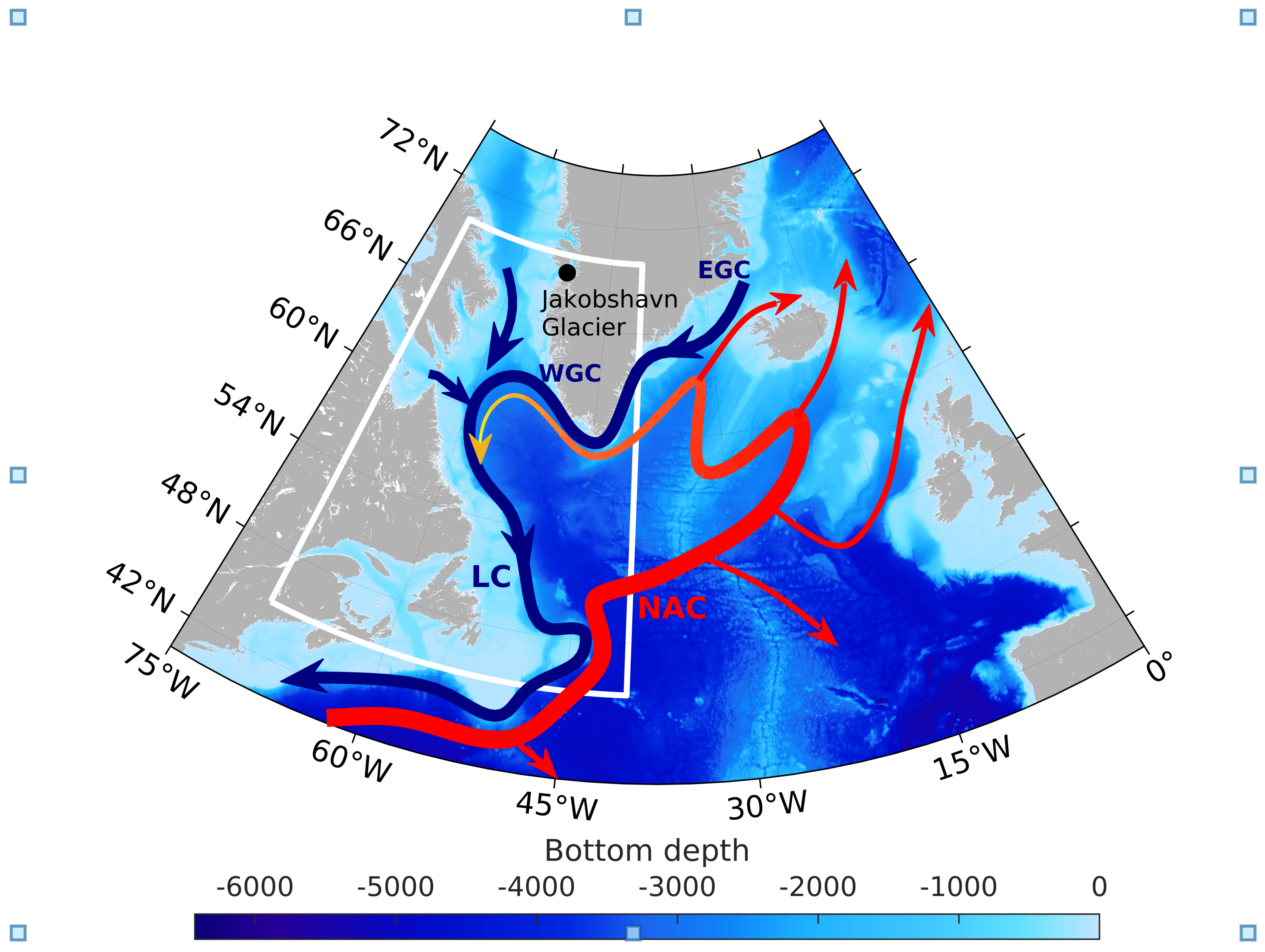


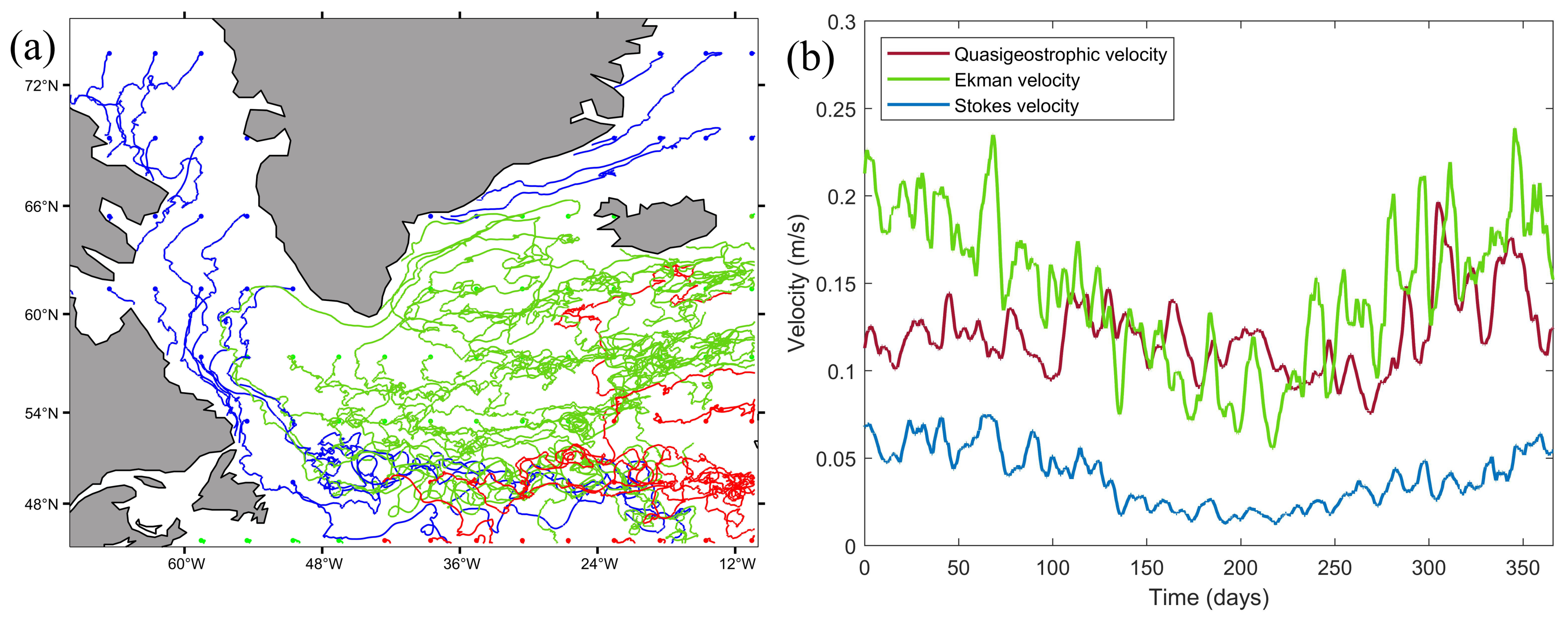


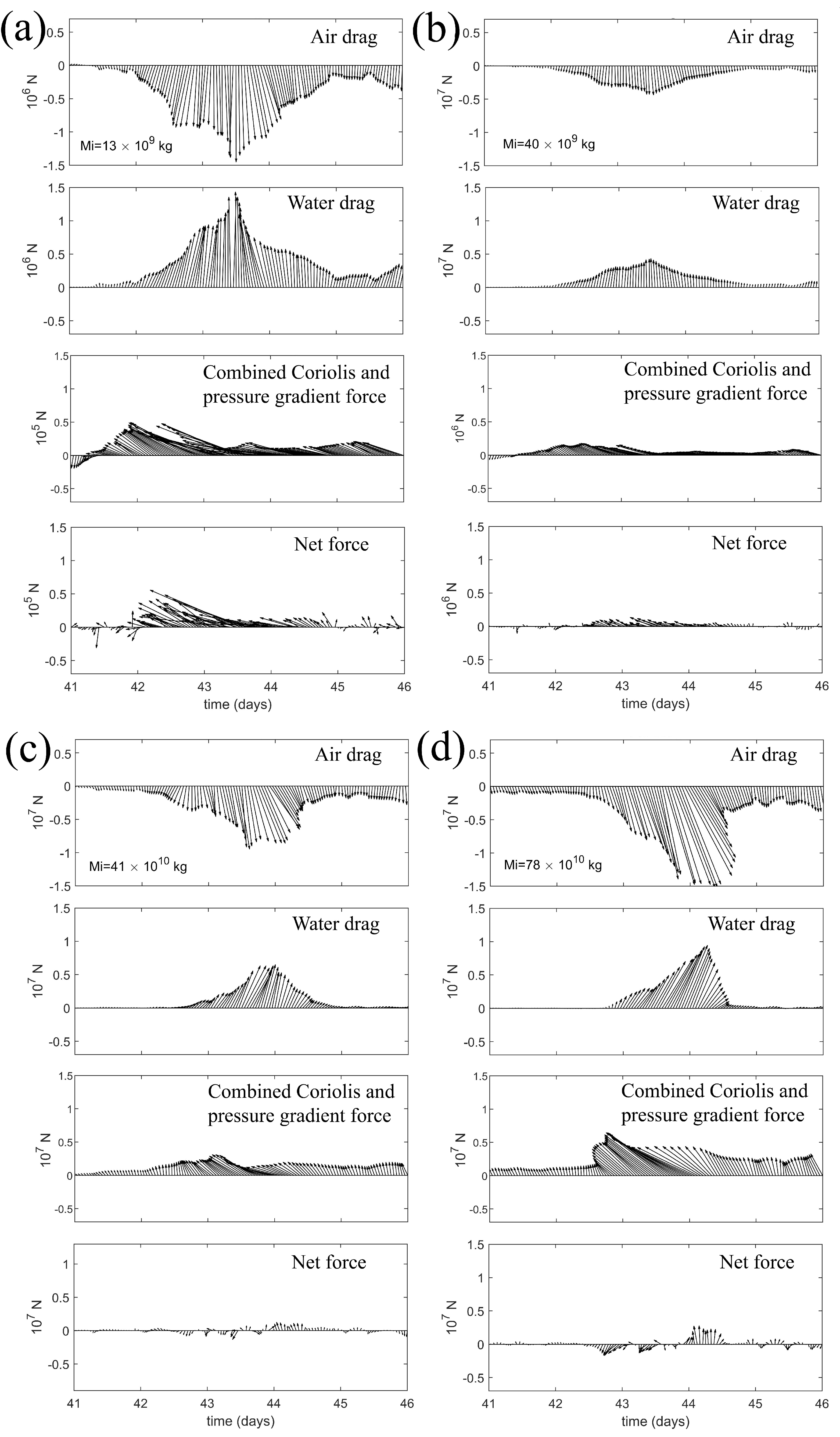
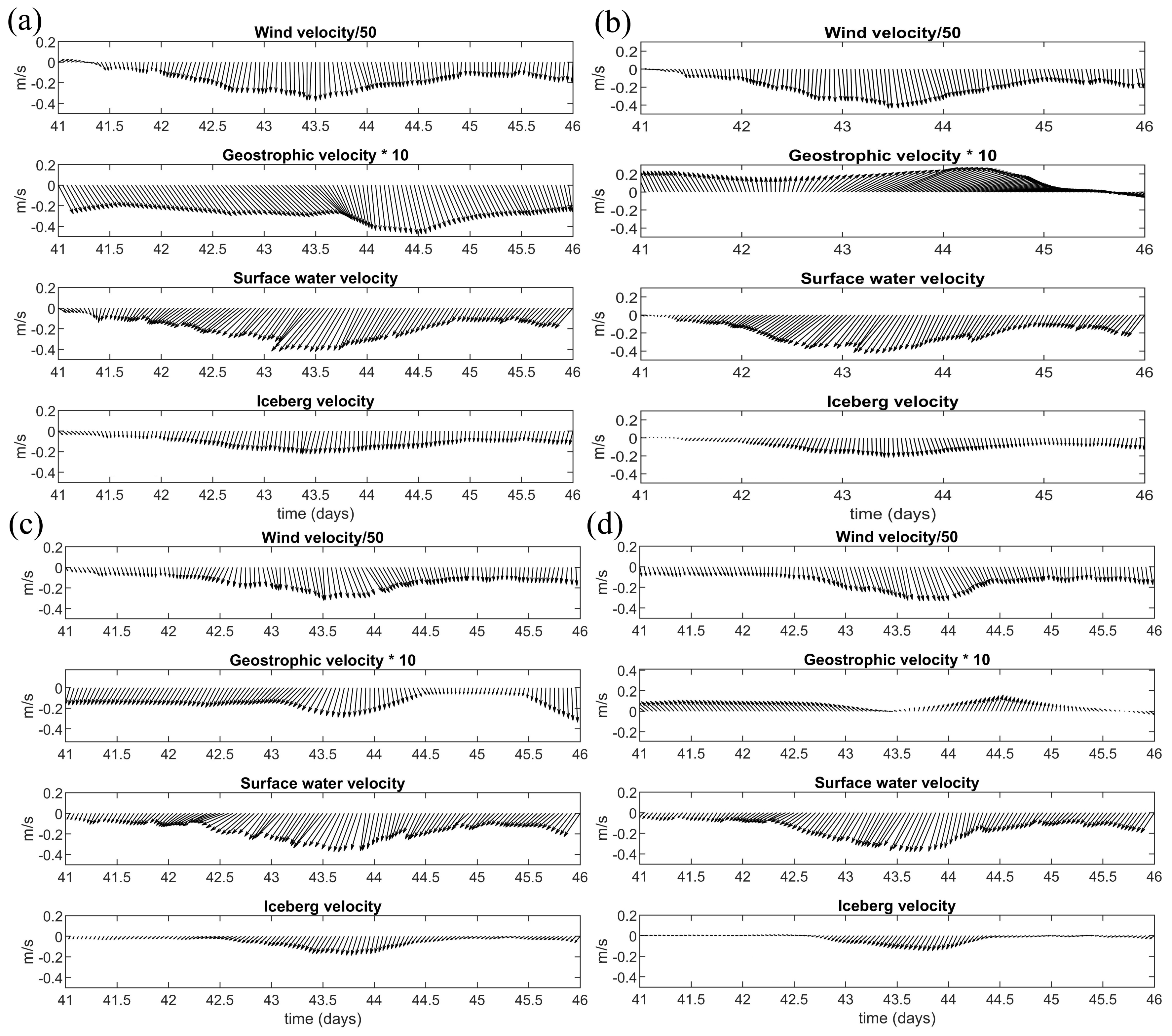
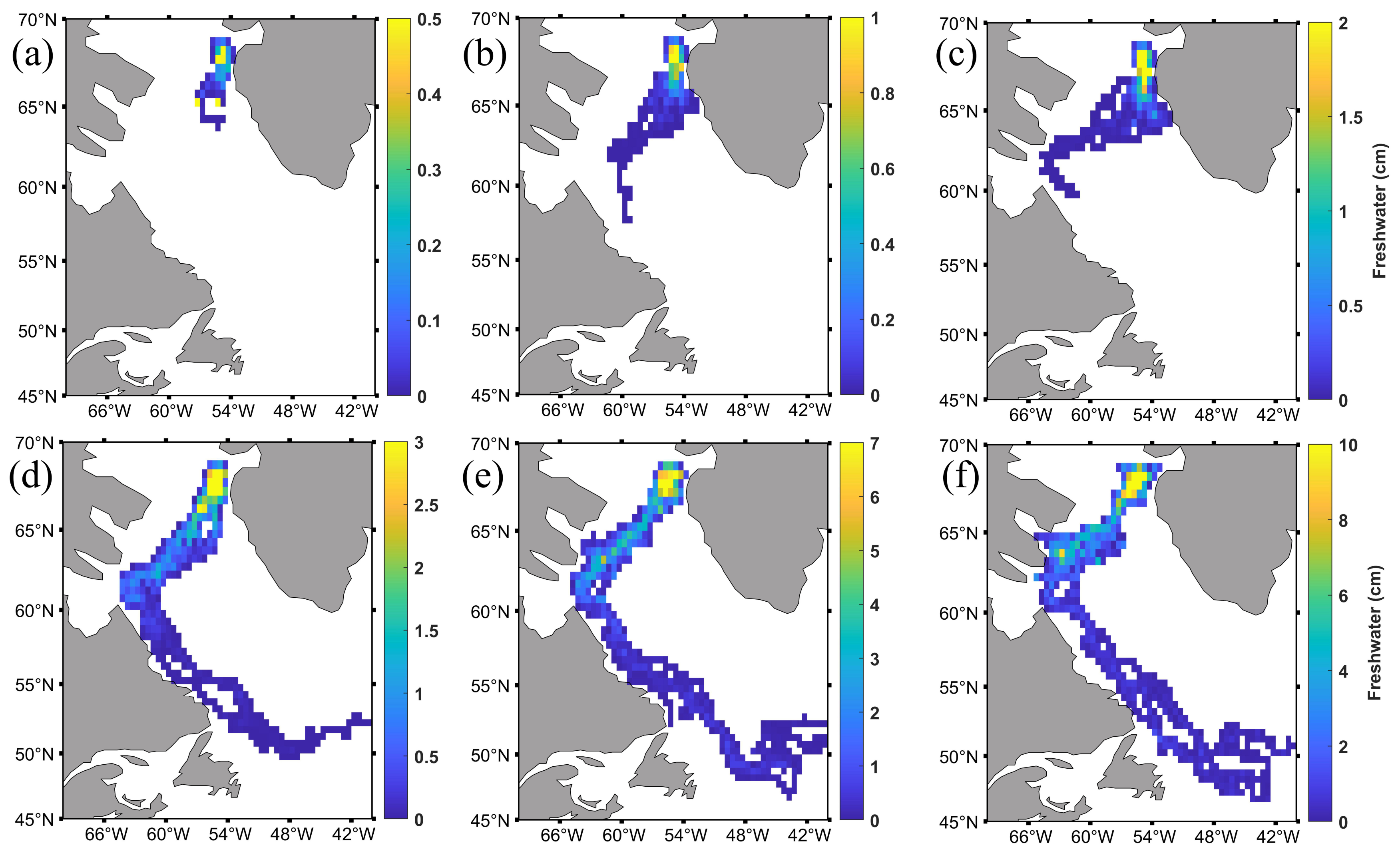
| Category | Length, m | Height, m | Mass, kg |
|---|---|---|---|
| 2 | 100 | 67 | |
| 3 | 200 | 133 | |
| 4 | 350 | 175 | |
| 5 | 500 | 250 | |
| 7 | 900 | 250 | |
| 8 | 1200 | 250 | |
| 9 | 1600 | 250 | |
| 10 | 2200 | 250 |
Publisher’s Note: MDPI stays neutral with regard to jurisdictional claims in published maps and institutional affiliations. |
© 2022 by the authors. Licensee MDPI, Basel, Switzerland. This article is an open access article distributed under the terms and conditions of the Creative Commons Attribution (CC BY) license (https://creativecommons.org/licenses/by/4.0/).
Share and Cite
Parayil, J.; Demirov, E.; Afanasyev, Y.D. Effects of Wind, Waves, and Currents on Icebergs and Surface Floats in the Labrador Sea: A Modeling Study. J. Mar. Sci. Eng. 2022, 10, 1167. https://doi.org/10.3390/jmse10091167
Parayil J, Demirov E, Afanasyev YD. Effects of Wind, Waves, and Currents on Icebergs and Surface Floats in the Labrador Sea: A Modeling Study. Journal of Marine Science and Engineering. 2022; 10(9):1167. https://doi.org/10.3390/jmse10091167
Chicago/Turabian StyleParayil, Jamseena, Entcho Demirov, and Yakov D. Afanasyev. 2022. "Effects of Wind, Waves, and Currents on Icebergs and Surface Floats in the Labrador Sea: A Modeling Study" Journal of Marine Science and Engineering 10, no. 9: 1167. https://doi.org/10.3390/jmse10091167
APA StyleParayil, J., Demirov, E., & Afanasyev, Y. D. (2022). Effects of Wind, Waves, and Currents on Icebergs and Surface Floats in the Labrador Sea: A Modeling Study. Journal of Marine Science and Engineering, 10(9), 1167. https://doi.org/10.3390/jmse10091167







